James Maliszewski's Blog, page 56
May 12, 2024
Secrets of sha-Arthan: Tomb Robber
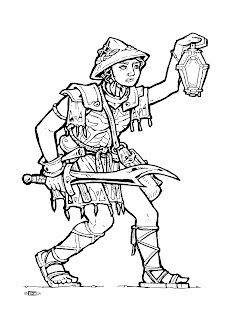 A tomb robber by Zhu BajieTomb Robber
A tomb robber by Zhu BajieTomb Robber
Prime Abilities: DEX and INTHit Points: 1d6 per level Starting Possessions: Leather breastplate, dagger, one-handed weapon, tool bag, 3d6 × 5ul
An almost universal custom among the myriad peoples and cultures of sha-Arthan is the burial of grave goods to aid the deceased in his journey to the afterlife. A tomb robber is someone who makes his living by stealing these goods, despite the strong taboos against it. The skills he acquires in these illicit endeavors make the tomb robber a valuable addition to expeditions into the Vaults.
AlertnessThanks to his keen awareness of imminent danger, a tomb robber reduces the chance of his party being surprised to 1-in-6.
SkillsA tomb robber begins with four +1 bonuses that may be applied to any of them following skills: Architecture, Climb, Lore, Luck, Search, Stealth, Survival, and Tinker. Each bonus must be applied to a different skill. Every level thereafter, he gains two additional +1 bonuses that can be applied to any of the aforementioned skills. Dead Languages: Because of his familiarity with inscriptions in ancient ruins, the tomb robber does not suffer the usual –3 penalty for attempting to read dead languages.Improvisation: If specific equipment is normally required to use a skill he possesses, a tomb robber does not require it. If he does possess the equipment, he gets a +1 bonus to his roll. Trap AvoidanceTo succeed in his chosen professional, a tomb robber develops a knack for avoiding traps. This knack grants him a +2 bonus to saving throws to avoid the effects of traps.
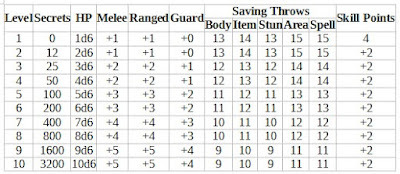
May 10, 2024
Speaking of Miniatures ...
Behold! Qualos – guardian of the Duck Temple. This is an official RuneQuest miniature produced by Infinity-Engine. Whether you use miniatures in your games or not, it's hard to deny that this one is pretty amazing.
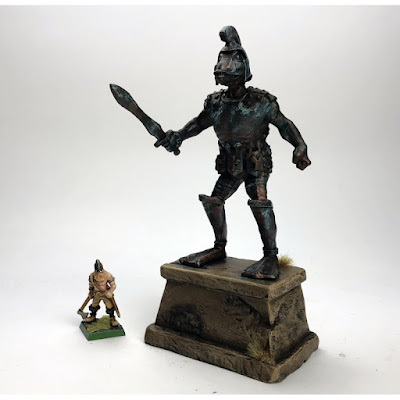
What's Behind That Door?
It is, of course, well established that roleplaying games as we know them today grew out of the hobby of miniatures wargaming. I suspect that's why 25mm miniature figures continued to be made and sold for use with RPGs, even though, in my personal experience, very few people had much use for them at the table. That was certainly the case for me. Despite this, lots of games continued to recommend the use of miniature figures as an aid to play, including some rather unexpected ones, like Call of Cthulhu.
Call of Cthulhu quickly became one of my favorite roleplaying games and I acquired all of the support products for it that I could both find and afford – like the miniatures sold by Grenadier Models. After losing the AD&D license in 1982, Grenadier tried to maintain its presence in the RPG world by picking up licenses to produce figures for other popular roleplaying games, like Traveller and Call of Cthulhu. They also tried their hand at publishing adventures for both games, with very mixed results.
I owned the two boxed sets of Call of Cthulhu miniatures, the first of which was dedicated to adventurers (though the box says "adventures," which I assume was an error). Here's the cover, showing Indiana Jones, Al Capone, and Professor Plum preparing to burst into the room behind a closed door.
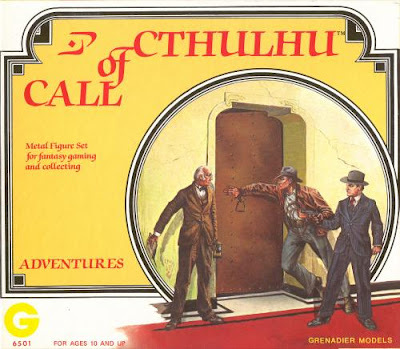 The second boxed set depicts a night gaunt, a deep one, and a ghoul, who lie in wait behind the very same door the adventurers are about to open. Taken together, they form a fun little diptych that, to my shame, I don't think I even recognized until several years after I'd bought them.
The second boxed set depicts a night gaunt, a deep one, and a ghoul, who lie in wait behind the very same door the adventurers are about to open. Taken together, they form a fun little diptych that, to my shame, I don't think I even recognized until several years after I'd bought them.
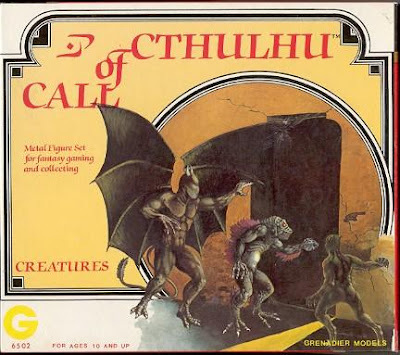
Because I rarely painted or used these miniatures, I'm not completely sure why I bought them. I suppose it's because I thought I was supposed to do so. The rulebooks recommended their use, companies sold them, and nearly everyone I knew had at least a handful of minis they'd carry around in their dice bag, even though, like me, they almost never did anything with them. Owning miniatures was simply part of the culture of the hobby at the time. Like dice, they were part of the "uniform." You had to have them, if you wanted to be part of the "team." I don't think that's as common a feeling anymore, though I still see plenty of miniatures for sale in game stores.
What are your experiences with miniatures? Do you own many and, more importantly, do you use them? I'd be very curious to know.
May 9, 2024
I'm a Terrible Player
Almost from the moment I discovered roleplaying games, I've primarily been a referee. To some degree, I was thrust into this role by necessity, since few of my friends were all that interested in sitting behind the screen themselves. Fortunately for them, I liked being the referee. I enjoyed making maps and creating adventure locales and thinking up new ways to challenge my players. Despite my perpetual stage fright – I still struggle with this before nearly every session I run – I also enjoy describing situations to my players, roleplaying NPCs, and thinking on my feet in response to their harebrained schemes. In short, refereeing is fun, which probably explains why I've got three different campaigns on the go at the present moment.
Of course, I've been a player, too. Right now, for instance, I'm playing in a dear friend's Traveller campaign set in the Crucis Margin sector and am really enjoying it. Nevertheless, there's no denying that, by most standards, I'm a terrible player. I don't say this lightly; this isn't studied self-effacement. I really do think I'm a pretty mediocre player, especially when I compare myself to the dozens of people whom I've refereed over the years – certainly when compared to the players of my House of Worms Empire of the Petal Throne campaign.
What do I mean when I say "terrible player?" Firstly, I mean that I rarely immerse myself in the world of any game I play. Instead, I retain varying degrees of detachment, sometimes to the point of treating my character as something akin to a token in a boardgame, which is to say, an abstract playing piece with little distinctiveness or personality. That might not seem like much of a sin, particularly if, like Gygax, you don't equate roleplaying with amateur thespianism. That's not quite what I mean here. Rather, I mean that I don't make much effort to play my character as something distinct from the rules he brings to bear on a session – abilities, skills, spells, gear, etc. He's not a fictional avatar but mostly a game construct.
Secondly, and perhaps more damningly, I get bored easily and don't pay attention to what's going on during a session when my character's not directly involved. To some extent, this is a consequence of my detachment. Since I view my characters mostly as vehicles for game mechanics, it's uncommon for them to engage in other activities that don't directly relate to them. Combat, for example, always catches my attention, as it directly involves all the characters present. On the other hand, lengthy discussions of in-game problems or details often leave me cold and I have to work hard to keep myself focused on the game. This second sin is an odd one. When I'm refereeing, I absolutely adore listening to the players spend long stretches of time discussing and debating new pieces of information their characters have just obtained or planning the strategy for their next endeavor. Indeed, those are among my favorite things about roleplaying. Perhaps I find them so appealing precisely because these are the kinds of in-game activities of which I don't seem to be capable.
I do think there's probably a connection between my long years participating in the hobby primarily as a referee and my terrible skills as a player. As a referee, I am constantly engaged in each and every session. As I mentioned above, I love roleplaying NPCs, describing details, responding to player queries, and so on. Even when I'm not directly involved in what's happening, I nevertheless have to pay attention in order to keep up with the action and determine what happens next. Likewise, after a session ends, I'm frequently thinking about the next session and what might happen during it. I can't tell how many times over the decades I've fallen asleep thinking about some aspect of a campaign I'm currently refereeing, pondering its possibilities.
Could it really be that, because a referee is such a large role, that having to take on the role of a "mere" player feels small and uninteresting? That seems the most obvious explanation, but I'm not sure if it's the right one. The difficulty in assessing this is compounded by the fact that, for all of this, I still enjoy playing. The aforementioned Traveller campaign is remarkable in its scope and imagination. I like the people with whom I'm playing and I look forward to each new session. Yet, for all of that, I still feel as if I'm not a very good player: I'm too distant and uninvolved most of the time and I worry it impacts others negatively.
Does anyone else feel this way?
May 7, 2024
Retrospective: Raiders of the Lost Ark (Atari)
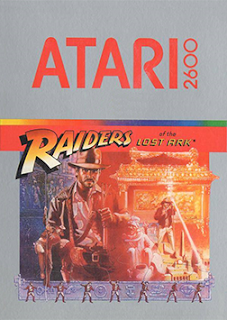 Though I've generally kept these Retrospective posts to looking back at roleplaying and boardgames that I thought worthy of discussion, I have occasionally turned the spotlight onto computer and video games as well. In the '80s, I never owned a "home computer," as we used to call them in those ancient days, but I did own the Atari Video Computer System (VCS), later dubbed the Atari 2600. I also had an enviable collection of game cartridges for it, two of which I think merit a post: Adventure, about which I've previously written, and Raiders of the Lost Ark.
Though I've generally kept these Retrospective posts to looking back at roleplaying and boardgames that I thought worthy of discussion, I have occasionally turned the spotlight onto computer and video games as well. In the '80s, I never owned a "home computer," as we used to call them in those ancient days, but I did own the Atari Video Computer System (VCS), later dubbed the Atari 2600. I also had an enviable collection of game cartridges for it, two of which I think merit a post: Adventure, about which I've previously written, and Raiders of the Lost Ark.
Released in 1982, Raiders of the Lost Ark was (obviously) a tie-in product for the action-adventure film of the same name released the year before. Historically, tie-in products like this tend to be mediocre at best, with most being little more than vehicles for making a quick buck by association with a popular book, TV show, or movie. By all rights, that's what one might reasonably expect of this game cartridge too – except that it's actually one of the more complex, imaginative, and enjoyably frustrating games Atari ever made for its first game console.
It's that enjoyable frustration that's the main reason I still have such affection for the game. Strange though it might be for some to imagine, I actually enjoyed video and computer games whose difficulty – or at least perplexity – made me want to tear my hair out. Indeed, their difficulty was a big part of their appeal, because it suggested that, if I managed to beat them, I'd actually achieved something. It's similar to why, as kids, my friends and I enjoyed testing our wits against a Killer DM. Sure, it was tough and often downright unfair, but to win against such odds felt like an accomplishment and we cherished those moments way more than easy wins.
Raiders of the Lost Ark was not an easy win. Completing it successfully took a lot of thought and patience, not to mention above average hand-eye coordination, owing to its unusual control set-up and the finicky nature of said controls. In very broad strokes, the game recreated Indy's adventures in search of the Map Room that will lead him to the resting place of the fabled Lost Ark of the Covenant. The resting place of the Ark is randomly determined with each game reset, meaning that, should you fail, you can't necessarily carry over anything you've learned in your previous attempts to a new one. In addition, Indy requires the aid of certain items he can find hidden in various locations and these, too, are not always in the same location.
This randomness is only one part of what made the game so frustrating to play. Another is that it required both joysticks to play. One was used in the expected way, allowing the player to control Indy's movement and actions on-screen. The other was used to control inventory. Unlike Adventure, which only allowed the player to possess a single item at a time, Raiders of the Lost Ark let you possess several, as if Indy had a backpack filled with gear. By moving a cursor among the items you possessed, the player could the one he wished Indy to use at any given time. This was very cool and quite innovative at the time, but it could also be demanding in play, especially if you had to quickly switch between items.
However, the main reason the game was so frustrating was the sparseness of its manual, which didn't tell the player much about how the goals of the game could be achieved. Instead, you were largely left to your own devices to figure out how all of the game's elements worked toward a successful conclusion. The manual includes descriptions of most of the locations and items found in the game, but not all of them. Likewise, it does include "helpful hints," but, again, these don't answer every question a player might have. "After all, what's an adventure game without surprises?" the manual asks. Consequently, even if you read the manual cover to cover, there are still very important aspects of play that you can only discover through play.
This is what made the game so enjoyably frustrating to me. To this day, more than forty years later, I can still recall the joy I felt when I first stumbled across an item not listed in the manual the possession of which was essential to finding the location of the Ark. Similarly, I remember when, in the midst of foolishly falling off a cliff to my doom – I wasn't quick enough in making use of the parachute in my inventory – I noticed something for the first time that I would later use to solve another mystery in the game. Neither of these discoveries were in the manual; I could only learn of them through trial and (much) error.
By the standards of today, Raiders of the Lost Ark is unbelievably primitive. Heck, by the standards of games released just a year or two later, it's primitive. Yet, for all that, it remains one of my favorite video games of all time, because it challenged me just enough that I couldn't rack up an easy win but without so dispiriting me that I gave up completely. Not coincidentally, this is my ideal when it comes to dungeon design, too, so perhaps I was the perfect target audience for this game. This is a foundational game design for me and I suspect I've been chasing the high of enjoyable frustration I gave me ever since.
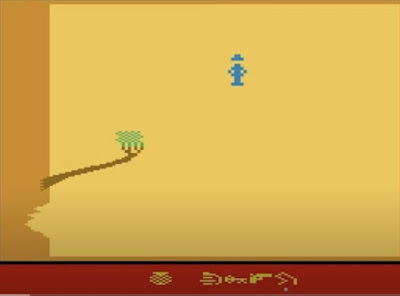 Indy notices something as he falls to his pixelated doom
Indy notices something as he falls to his pixelated doom
How Do You Solve a Problem Like Kirktá?
First, thank you to everyone who took the time to make comments or send me emails regarding yesterday's post about upcoming events in my House of Worms campaign. I've gotten a number of excellent suggestions and I now have a better handle on how I'll likely proceed, though I'd be happy to continue receiving more suggestions. After the Kólumejàlim, as the Choosing of the Emperors is known in Tsolyáni, has taken place, I'll write a post or two about it, because I am sure that, no matter how it turns out, it will be of interest to my readers. That likely won't occur until sometime this summer, as the campaign is currently focused on other matters at the moment and I'm not ready to shift gears quite yet.
Aside from my already stated reasons for wanting to adjudicate the Kólumejàlim in this way, there's also another: one of the player characters is secretly an heir to the Petal Throne. Years ago, when a new player joined the campaign, he asked if he could base his character on one from the original Tékumel campaign in Minneapolis. Named Kirktá, he was a priest NPC whom the characters in the Twin Cities campaign later discovered was one of the emperor's secret heirs, whose true identity was hidden, unknown to almost anyone, including himself. I had no objection to the new player basing his character on Kirktá, largely because I never expected it to amount to anything.
And it didn't. For many years, there was never a hint that Kirktá – my Kirktá – was anything other than he appeared to be, namely, a young and naive priest of Durritlámish, the Black Angel of the Putrescent Hand. He served as protégé and amanuensis to Keléno, one of the four remaining original player characters of the campaign, without complaint. Indeed, Kirktá had something of a reputation as being incapable of making decisions for himself, deferring instead to the wisdom and experience of his master (and any other PC who cared to offer an opinion on what Kirktá ought to do). It's a fun dynamic and soon became one of the hallmarks of the campaign.
Then, a little more than a year ago, the characters reunited with an old antagonist of theirs, an Undying Wizard known as Getúkmetèk. Like a lot of Undying Wizards, Getúkmetèk existed outside of normal time. Consequently, when the characters encountered him, there was no telling exactly where the wizard was on his own personal timeline. On this occasion, Getúkmetèk was quite young, early in his own career and not yet an Undying Wizard. In fact, it became increasingly clear that it was due to their interactions with him early in his life (but late in that of the characters, relatively speaking – non-linear time is weird) that he would eventually become antagonistic toward them.
When this younger Getúkmetèk met the characters, he greeted them pleasantly, since, from his perspective, he hadn't yet met any of them – or, at least, most of them. Somehow, he already knew Kirktá and addressed him differently than the others, using a formal Tsolyáni second person pronoun reserved only for the emperor, "you of supernal omnipotence," that is probably unknown to most characters, given its exceedingly uncommon usage. One of the characters, Nebússa, comes from a very high clan involved heavily in imperial service. He recognized the pronoun and quickly put two and two together, realizing for the first time in the campaign that Kirktá was likely a hidden heir to the Petal Throne.
Initially, Nebússa kept this secret to himself, not even telling Kirktá. However, events eventually required that he reveal it, to the surprise and incredulity of his clan mates. There was a lot of debate about what the characters should do with this information, as well as the realization that, if Nebússa figured it out based on very limited information, there were probably others within Tsolyánu who also knew it and might seek to take advantage of it. That's partly why the characters elected to undertake a lengthy, months-long journey outside the Imperium: to keep Kirktá safe. However, once the Kólumejàlim is declared, events may overtake them. What happens next is anyone's guess, hence my desire to establish a means to handle the Choosing of the Emperors, just in case Kirktá decides to participate ...
May 6, 2024
Polyhedron: Issue #25
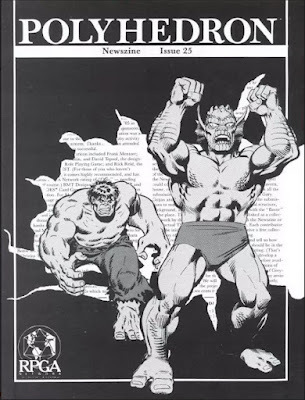 Issue #25 of Polyhedron (September 1985) features eye-catching artwork by the Marvel Bullpen, depicting the Hulk and long-time foe, the Abomination, bursting through the cover. Both characters appear in the issue's Marvel Super Heroes article – a first for the newszine. At the time, I was quite pleased by this expansion of Polyhedron's coverage, because I was a big fan of MSH and was always on the look-out for new material (particularly write-ups of Marvel characters that hadn't yet appeared elsewhere).
Issue #25 of Polyhedron (September 1985) features eye-catching artwork by the Marvel Bullpen, depicting the Hulk and long-time foe, the Abomination, bursting through the cover. Both characters appear in the issue's Marvel Super Heroes article – a first for the newszine. At the time, I was quite pleased by this expansion of Polyhedron's coverage, because I was a big fan of MSH and was always on the look-out for new material (particularly write-ups of Marvel characters that hadn't yet appeared elsewhere).Normally, "Notes from HQ" is filled with RPGA-related ephemera and thus doesn't command my attention for long. This time, though, part of it is of greater interest, specifically the call for Dungeon Masters to submit "a store, tavern, house, city block, NPC, street encounter, guild" for inclusion in a fantasy setting to be used by the RPGA as a "home base" and possible locale for adventures. Robert Asprin's Thieves' World is referenced as an inspiration and it's stated that Gary Gygax has agreed to allow this city to be placed in his World of Greyhawk setting. If any of this sounds familiar, that's because I suspect the project was eventually retooled for use with the Forgotten Realms, becoming Ravens Bluff, the Living City, an RPGA staple for years to come.
Jon Pickens offers up a second part of his "Unofficial Magic-User Spells" series, again looking to existing magic items as source of new spells (like the ring of spell turning and ring of x-ray vision). It's fine, if a bit unimaginative, though I cannot forgive the consistent misspelling of "absorption" as "absorbtion" throughout, especially when the magic item that inspired it, the rod of absorption, spells it correctly. The "RPGA Network Player and Judge Standings" is hardly worth mentioning, since it's little more than three pages' worth of names. Looking through them, I spotted the usual assortment of TSR employees and freelancers, along with a few others whose names I recognized from Dragon and elsewhere. I wonder if any readers of this blog had earned enough tournament XP to make it onto the list?
Part II of Frank Mentzer's AD&D adventure, Needle, also appears in this issue. Having found the titular needle – a magical obelisk – in Part I, the characters are now tasked with removing it for transport back to their homeland while dealing with hostile bullywugs and pirates. The adventure is quite fascinating, in that it's mostly a matter of resource management and logistics. The characters command a team of workers and mercenaries over the course of the several weeks needed to achieve their goal. How well they manage their resources, as well as how they respond to various threats, determine whether or not their mission is successful. I have no idea how it would be to play, the idea behind this scenario sounds compelling.
Michael Przytarski's "Fletcher's Corner" returns, talking about high-level adventures this time. That's a topic of great interest to me, since there aren't a lot of good examples of them in my opinion and I'd love to read some good advice on how to create my own. Sadly, there's not much meat to this article. It's mostly brief nuggets ("Try not to be bring the gods into it") intended to keep things somewhat grounded and avoiding boredom ("Three red dragons are fun, but they can become tiresome"). Perhaps the article's brevity (one page) prevents Przytarski from getting into the weeds of this topic, I don't know. Regardless, I didn't find what I was looking for here, which is a shame. My quest continues.
"Rampage" by Roger E. Moore is a straightforward Marvel Super Heroes scenario, in which four different super-strong characters – the Hulk, Hercules, the Abomination, and Titania – in the streets of New York. It's not deep, but it's fun. I also appreciate the way that Moore presents different Karma award charts for each character as a way to highlight their differences. That's something I always liked about Marvel Super Heroes and that's harder to implement in a game where the characters are all original creations of the players rather than established personalities.
With apologies to Rembert N. Parker, I'm going to pass over his "How to Succeed at Judging an RPGA Network Event," because it's of minimal interest to me. "Dispel Confusion" consists of two full pages of AD&D questions, with no other RPGs represented. By and large, the questions this issue concern ambiguities in the rules and, as such, aren't that interesting to discuss here. The most notable question concerned psionics and its use, with the answer noting that psionics will be revised "in the future." Rounding out the issue is a positive review of Paranoia, an old fave of mine, though it's been years since I've attempted to play it. Maybe I should change that.
As always, Polyhedron is so much more of a mixed bag than is Dragon and it's frustrating. Most issues contain good material, but very few are consistently good. That probably explains why I eventually stopped reading it, while I continued with Dragon well into the 1990s. I suspect this is because Polyhedron always had a much more "amateur" quality, which limited both its audience and its submissions. It's a real pity.
May 5, 2024
Looking for Ideas
This concerns a topic about which I've written before, but which is likely to become more important in my ongoing House of Worms Empire of the Petal Throne campaign, namely, the death of the emperor of Tsolyánu and the choosing of his successor. There is no primogeniture in Tsolyánu. Instead, all the children of the emperor, who are given "the Gold" (a specially engraved circular plaque) upon their births, are eligible to compete for the right to ascend the Petal Throne as his successor. To provide some additional context, here's what the Tékumel Source Book has to say about this competition:
As soon as an old monarch has died and the great sarcophagus sealed away in the black vaults below Avanthár all of those who possess the Gold (plus any remaining undeclared heirs or heiresses who must be hurriedly produced by their patrons) are summoned to Béy Sü for the Choosing of the Emperors. There they undergo a traditional roster of tests which cover every facet of character thought by the Tsolyáni to be needful for a ruler: bravery, endurance, cunning, physical prowess, judgment, knowledge of history and the arts, competence in "magic," and a dozen other fields. A candidate has the right to name champions to represent him or her in any three of these categories but must compete in person in all the others. Each event is carefully judged, and the strongest contenders are taken at last within the sacred precincts of the Temple of Hná'lla where the Holy Adepts of all the temples and the High Princeps of the Omnipotent Azure Legion make the final selection according to ancient and secret ritual methods. The winner is then declared and conveyed to Avanthár. The losers are given over to the Temple of Karakán for sacrifice.
I've decided that I'd like to play out the Choosing of the Emperors in in my campaign, with each of my eight players taking the role of one of the candidates for the throne. The problem I am having – and the reason why I'm turning to my readers for ideas – is that there is very little information about the competition in any published Tékumel materials. The section I've quoted above is close to all we know about the competition and its trials and, as you can see, it's quite vague.
In the original Space Gamer article linked to at the start of this post, there is a lengthy description of how one referee (Robert L. Large, Jr.) handled the Choosing in his campaign. He made use of only three tests – a series of arena battles, a series of magical duels, and a puzzle chamber. The account is very interesting, because Large made use of other games, like FGU's Gladiator, TSR's War of Wizards, as adjuncts to Empire of the Petal Throne itself. I'm very open to this sort of approach, but the bigger issue for me is: what sorts of contests are employed?
The Tékumel Source Book references "a traditional roster of tests" that includes more than a dozen areas of competence, not merely the three that Large used for his EPT campaign back in 1976. I suppose it could be argued that he was simplifying the Choosing of the Emperors for the sake of play. Certainly, I don't want the process of choosing a new emperor in my campaign to take up months of weekly play, especially if the roster of candidates is large. But what to do? What's the best – and most fun – way to pit the various heirs against one another so that the end result is unpredictable, even by me?
One of my players long ago suggested that the Choosing of the Emperors was probably akin to a competitive dungeoncrawl. This is an intriguing notion, if only because one of the features of Tékumel as a setting is that most cities have an "underworld" beneath it, representing the ruins of earlier settlements upon which they've been built. Avanthár, the ancient citadel of the emperors, is very ancient place, with all manner of passages and tunnels and ancient technology hidden beneath it, so I can easily imagine trials being conducted in such an environment. When discussing this with my players at our last session, we half-joked that a trap and puzzle filled maze like The Tomb of Horrors would be ideal for this purpose, if most of us weren't already intimately familiar with it.
So, that's where things stand at the moment. I very much want to play out the Choosing of the Emperors, but I have only a few ideas of how best to simulate them. I'd like the experience to be memorable and fun, as well as unique, but I must confess to having few ideas how best to achieve this without going to the trouble of creating an entirely new game for this purpose. Ideally, I'd be able to use Empire of the Petal Throne as the foundation, statting up all the heirs as characters and then subjecting them all to various trials. However, I'm not sure that's necessarily the best approach, which is why I'd love to hear the thoughts of others. If you have any ideas, thoughts, or suggestions, I'd love to hear them.
Thanks in advance!
May 3, 2024
50 years in the Dungeon
May 2, 2024
Landfall!
Never having been a huge reader of comics, I keep forgetting that, during the late '80s and early 1990s, DC Comics published a number of titles based (mostly) on Dungeons & Dragons settings. One of them was set in Krynn, the world of Dragonlance. From what I understand, the Dragonlance comics were prequels that took place before the events of the first novel, Dragons of Autumn Twilight, and consequently introduced a number of original characters to serve as its protagonists alongside more familiar names.
Since I haven't had the chance to read these comics, I don't have much more to say about them specifically. However, I am fascinated to discover that, starting with issue #22 (August 1990), the series had a fair number of issues whose stories took place on the continent of Taladas, the setting of the Time of the Dragon boxed set for which I retain a fondness. I suppose this makes sense. If the comic writers had to keep away from the more familiar War of the Lance storyline, looking to a new and mostly undeveloped part of the larger Dragonlance world is a good choice.
Did anyone read these or any of the other TSR comics published by DC? Were any of them any good?
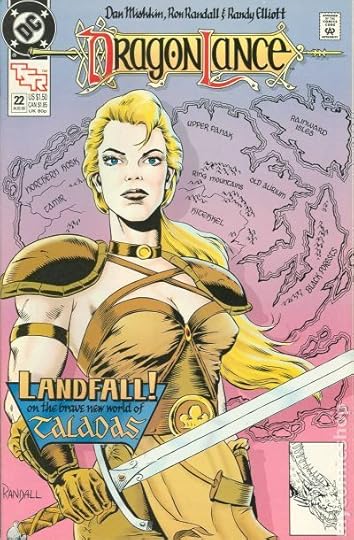
James Maliszewski's Blog
- James Maliszewski's profile
- 3 followers



